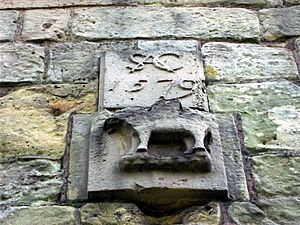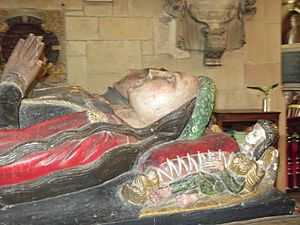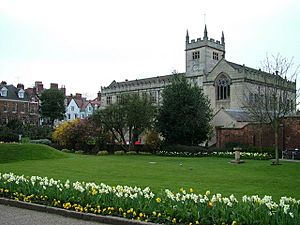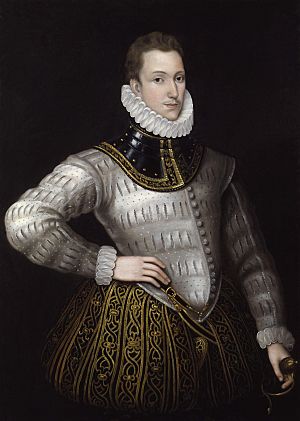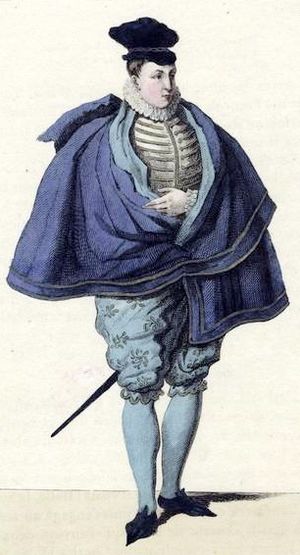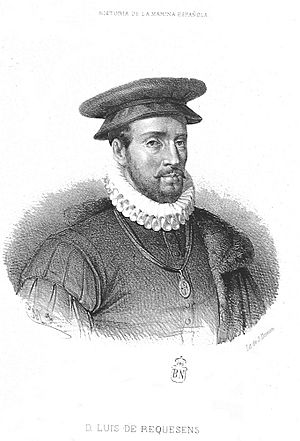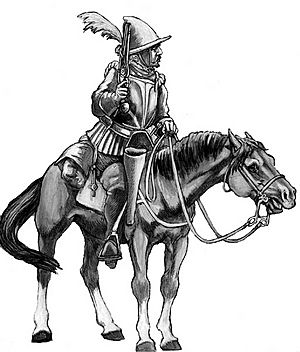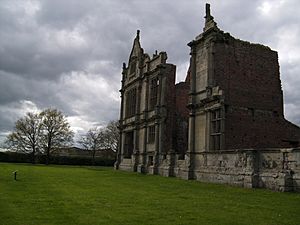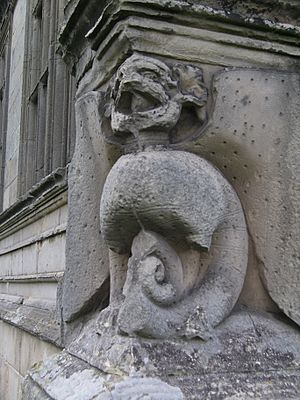Robert Corbet (died 1583) facts for kids
Robert Corbet (1542–1583) was an English landowner and diplomat during the time of Queen Elizabeth I. He was also a Member (MP) for Shropshire, his home county.
Contents
Early Life and School
Robert Corbet was the oldest son of:
- Sir Andrew Corbet from Moreton Corbet, Shropshire.
- Jane Needham from Shavington Hall, Shropshire.
The Corbet family had been important landowners in Shropshire for a long time. Their main home was Moreton Corbet Castle. Robert's father, Sir Andrew, was a key supporter of the Queen's religious changes. He was also a leader in the Council in the Marches of Wales, a special government group.
Robert was born when his father was quite young. He was one of at least eleven children. The name Robert had been popular for Corbet family heirs for centuries. Robert's great-grandmother, Elizabeth Vernon, who lived until 1563, might have helped choose his name.
It's believed that Robert Corbet went to Shrewsbury School. His father paid the school for his three sons. The Corbet family had strong ties to the school. Robert's great-uncle, Reginald Corbet, helped get permission to start the school in 1548.
Shrewsbury School opened in 1552. It was known for its focus on humanistic learning and drama. This is likely where Robert learned different languages and developed an interest in other countries. These skills would be very useful later in his life.
Working for the Country
Member of Parliament for Shropshire
Many Corbet family members had been Members of Parliament (MPs) for Shropshire. Robert became an MP in 1566, taking the place of his great-uncle, Richard Corbet, who had passed away.
Parliament had started in 1563. It was very focused on who would become queen after Elizabeth. The queen stopped Parliament for a while, then called it back in 1566 to ask for money.
Robert was listed as "junior" to tell him apart from another relative named Robert. He served as an MP until Parliament ended in 1567.
Travels in Europe
In the 1570s, Robert Corbet traveled a lot in Europe. Sometimes, he traveled with Philip Sidney. Philip Sidney had also gone to Shrewsbury School. His father, Sir Henry Sidney, was a close friend of Robert's father, Sir Andrew.
In 1574, Philip Sidney wrote a letter recommending Robert Corbet to Hubert Languet. Languet was a diplomat in Vienna. Sidney described Corbet as a "very greatest friend" and a "man of high birth." He also said Corbet was good at languages and knew about war.
Corbet traveled to Vienna. He then planned to go to other cities like Prague and Nuremberg. However, his travel companion, Richard Shelley, became very ill. Corbet wrote to Languet, worried about Shelley.
Corbet also worried about his own journey. He heard that there was fighting in the areas he planned to visit. He asked Languet for advice. Shelley eventually recovered, and Corbet returned home the next year.
After his death, a record in Shrewsbury said that Robert Corbet was "of great estimation with the Queen’s Majesty." This was because he could speak many foreign languages. He had learned them during his long travels in his youth.
Becoming an Ambassador
In 1575, Robert Corbet was given an important job by the government. He was sent as a special messenger to the Spanish governor of the Netherlands, Luis de Requesens y Zúñiga.
The Netherlands was in a state of rebellion against Spain. The English government wanted to help bring about peace. Corbet's main task was to talk about trade between England and the Netherlands. He also had to stress that England and Spain both wanted to keep France out of the Netherlands.
However, there was a clear rule: England would not abandon the Protestant cause. The queen would only support Spain if they allowed their people to be free and live peacefully.
At first, Corbet's mission seemed to go well. He met Requesens and reported that the Spanish forces were not happy. But a week later, Requesens was much angrier. He blamed England for helping the Dutch rebels.
Corbet offered to go talk to the Dutch rebels himself. But Requesens refused. He didn't want it to look like he was making the first move for peace. Corbet asked to return home. He reported that Requesens would agree to peace, but only if the "Papistical religion" (Catholicism) was accepted.
Robert Corbet returned home by December 1575. He had done what was asked of him. He was rewarded by being made Master of the posts and chamberlain of the Exchequer. He was not asked to be an ambassador again.
Landowner and Builder
When Robert Corbet's father died in 1578, Robert inherited very large estates. These lands were mostly in Shropshire, but also in many other counties.
Because he was now a major landowner, Robert was made a Justice of the Peace for Shropshire in 1579. This was an important role, usually given to experienced people.
His father had been working on improving Moreton Corbet Castle. It likely became Robert's home. However, Robert quickly started building a brand new house right next to the old castle.
A writer named William Camden described it later. He said Robert Corbet "began to build in a barraine place a most gorgeous and stately house after the Italians modell." This new house was wide and impressive. It had large, rectangular windows and decorative columns. It was designed for a very different way of living than the old castle.
Robert's new house was built before many other famous Elizabethan houses. He used local builders and carvers. However, as Camden noted, he never fully finished the building. His brothers were left to complete it, but they never removed the old castle.
Death
In May 1583, Robert Corbet visited his uncle Walter Corbet in London. Both of them caught the bubonic plague. Robert died on May 30, a few days after his uncle.
His body was brought back to Moreton Corbet. He was buried on July 24, "next to his father and his ancientry very worshipfully." Robert did not have any sons who survived him. He had two young daughters. His younger brother, Richard, became his heir.
Family Life
Robert Corbet married Anne, the daughter of Oliver St John, 1st Baron St John of Bletso. They had two daughters:
- Elizabeth Corbet married Henry Wallop (died 1642).
- Their son, Robert Wallop, became a politician.
- Anne Corbet married Sir Adolphus Carey. They did not have children.
Both of Robert's daughters were very young when he died. Elizabeth was almost four, and Anne was only ten months old. Because there was no male heir, some of the Corbet family lands were lost when his daughters married.
Robert's wife, Anne, remarried after his death. Her second husband was Roland Lytton. They had several children together. Anne died in 1602.


